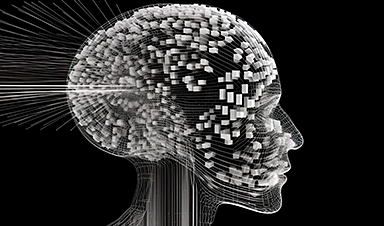The brain, despite its comparatively shallow structure with limited layers, operates efficiently, whereas modern AI systems are characterized by deep architectures with numerous layers. This raises the question: Can brain-inspired shallow architectures rival the performance of deep architectures, and if so, what are the fundamental mechanisms that enable this?
Neural network learning methods are inspired by the brain's functioning, yet there are fundamental differences between how the brain learns and how deep learning operates. A key distinction lies in the number of layers each employs.
Deep learning systems often have many layers, sometimes extending into the hundreds, which allows them to effectively learn complex classification tasks. In contrast, the human brain has a much simpler structure with far fewer layers. Despite its relatively shallow architecture and the slower, noisier nature of its processes, the brain is remarkably adept at handling complex classification tasks efficiently.
Research on Shallow Learning Mechanisms in the Brain
The key question driving new research is the possible mechanism underlying the brain's efficient shallow learning — one that enables it to perform classification tasks with the same accuracy as deep learning. In an article published in Physica A, researchers from Bar-Ilan University in Israel show how such shallow learning mechanisms can compete with deep learning.
Credit: Prof. Ido Kanter, Bar-Ilan University
"Instead of a deep architecture, like a skyscraper, the brain consists of a wide shallow architecture, more like a very wide building with only very few floors," said Prof. Ido Kanter, of Bar-Ilan's Department of Physics and Gonda (Goldschmied) Multidisciplinary Brain Research Center, who led the research.
"The capability to correctly classify objects increases where the architecture becomes deeper, with more layers. In contrast, the brain's shallow mechanism indicates that a wider network better classifies objects," said Ronit Gross, an undergraduate student and one of the key contributors to this work.
"Wider and higher architectures represent two complementary mechanisms," she added. Nevertheless, the realization of very wide shallow architectures, imitating the brain's dynamics, requires a shift in the properties of advanced GPU technology, which is capable of accelerating deep architecture, but fails in the implementation of wide shallow ones.
Reference: "Efficient shallow learning mechanism as an alternative to deep learning" by Ofek Tevet, Ronit D. Gross, Shiri Hodassman, Tal Rogachevsky, Yarden Tzach, Yuval Meir and Ido Kanter, 11 January 2024, Physica A: Statistical Mechanics and its Applications.
DOI: 10.1016/j.physa.2024.129513
News
Older chemical libraries show promise for fighting resistant strains of COVID-19 virus
SARS‑CoV‑2, the virus that causes COVID-19, continues to mutate, with some newer strains becoming less responsive to current antiviral treatments like Paxlovid. Now, University of California San Diego scientists and an international team of [...]
Lower doses of immunotherapy for skin cancer give better results, study suggests
According to a new study, lower doses of approved immunotherapy for malignant melanoma can give better results against tumors, while reducing side effects. This is reported by researchers at Karolinska Institutet in the Journal of the National [...]
Researchers highlight five pathways through which microplastics can harm the brain
Microplastics could be fueling neurodegenerative diseases like Alzheimer's and Parkinson's, with a new study highlighting five ways microplastics can trigger inflammation and damage in the brain. More than 57 million people live with dementia, [...]
Tiny Metal Nanodots Obliterate Cancer Cells While Largely Sparing Healthy Tissue
Scientists have developed tiny metal-oxide particles that push cancer cells past their stress limits while sparing healthy tissue. An international team led by RMIT University has developed tiny particles called nanodots, crafted from a metallic compound, [...]
Gold Nanoclusters Could Supercharge Quantum Computers
Researchers found that gold “super atoms” can behave like the atoms in top-tier quantum systems—only far easier to scale. These tiny clusters can be customized at the molecular level, offering a powerful, tunable foundation [...]
A single shot of HPV vaccine may be enough to fight cervical cancer, study finds
WASHINGTON -- A single HPV vaccination appears just as effective as two doses at preventing the viral infection that causes cervical cancer, researchers reported Wednesday. HPV, or human papillomavirus, is very common and spread [...]
New technique overcomes technological barrier in 3D brain imaging
Scientists at the Swiss Light Source SLS have succeeded in mapping a piece of brain tissue in 3D at unprecedented resolution using X-rays, non-destructively. The breakthrough overcomes a long-standing technological barrier that had limited [...]
Scientists Uncover Hidden Blood Pattern in Long COVID
Researchers found persistent microclot and NET structures in Long COVID blood that may explain long-lasting symptoms. Researchers examining Long COVID have identified a structural connection between circulating microclots and neutrophil extracellular traps (NETs). The [...]
This Cellular Trick Helps Cancer Spread, but Could Also Stop It
Groups of normal cbiells can sense far into their surroundings, helping explain cancer cell migration. Understanding this ability could lead to new ways to limit tumor spread. The tale of the princess and the [...]
New mRNA therapy targets drug-resistant pneumonia
Bacteria that multiply on surfaces are a major headache in health care when they gain a foothold on, for example, implants or in catheters. Researchers at Chalmers University of Technology in Sweden have found [...]
Current Heart Health Guidelines Are Failing To Catch a Deadly Genetic Killer
New research reveals that standard screening misses most people with a common inherited cholesterol disorder. A Mayo Clinic study reports that current genetic screening guidelines overlook most people who have familial hypercholesterolemia, an inherited disorder that [...]
Scientists Identify the Evolutionary “Purpose” of Consciousness
Summary: Researchers at Ruhr University Bochum explore why consciousness evolved and why different species developed it in distinct ways. By comparing humans with birds, they show that complex awareness may arise through different neural architectures yet [...]
Novel mRNA therapy curbs antibiotic-resistant infections in preclinical lung models
Researchers at the Icahn School of Medicine at Mount Sinai and collaborators have reported early success with a novel mRNA-based therapy designed to combat antibiotic-resistant bacteria. The findings, published in Nature Biotechnology, show that in [...]
New skin-permeable polymer delivers insulin without needles
A breakthrough zwitterionic polymer slips through the skin’s toughest barriers, carrying insulin deep into tissue and normalizing blood sugar, offering patients a painless alternative to daily injections. A recent study published in the journal Nature examines [...]
Multifunctional Nanogels: A Breakthrough in Antibacterial Strategies
Antibiotic resistance is a growing concern - from human health to crop survival. A new study successfully uses nanogels to target and almost entirely inhibit the bacteria P. Aeruginosa. Recently published in Angewandte Chemie, the study [...]
Nanoflowers rejuvenate old and damaged human cells by replacing their mitochondria
Biomedical researchers at Texas A&M University may have discovered a way to stop or even reverse the decline of cellular energy production—a finding that could have revolutionary effects across medicine. Dr. Akhilesh K. Gaharwar [...]





















